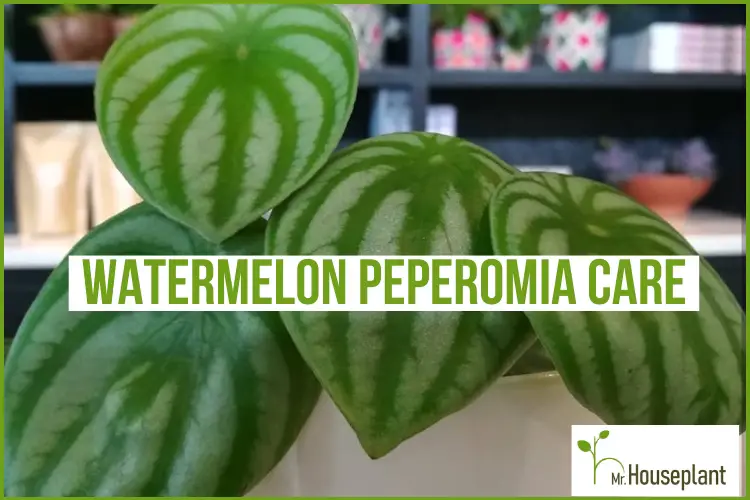
Struggling to keep your Watermelon Peperomia foliage lush and green? This post will address all your concerns and teach you all the tricks of the trade to become an expert in growing Peperomia, from light and water requirements, temperature and humidity needs to the best soil and fertilizer.
| Botanical Name (Latin Name/Scientific Name): | Peperomia argyreia |
| Common Name: | Watermelon Peperomia |
| Light: | Medium indirect light |
| Watering: | When the soil dries out to the bottom of the pot |
| Soil: | Well-draining mix |
| Repotting: | Once a year |
| Temperature: | 55°F to 75°F (13°C to 24°C) |
| Humidity: | 25-50% humidity, but adapts well to lower humidity |
| Toxicity for Pets: | Non-toxic |
| Toxicity for Humans: | Non-toxic |
| Propagation: | Stem or tip cuttings
Leaf cuttings Division |
| Pruning: | Prune dead or diseased growth or when you want the plant to branch out |
What is Watermelon Peperomia
Watermelon Peperomia belongs to the Peperomia genus, which comprises more than 1,000 species of tropical plants, native to South America. Watermelon Peperomia got its scientific name, Peperomia Argyreia, from the Latin word ‘’argyreia’’, which means ‘’silver’’, owing to the silver stripes on its leaves. This plant is native to Brazil and it grows to be 15-20 cm (6-8 inches) tall. Watermelon Peperomia has fleshy, green and silver striped leaves, which look like watermelon rind. The stems and leafstalks are dark red on these plants. Watermelon Peperomia have unusual, whitish flowers that rest on long, slender stems.
Some of Peperomia species, like the Peperomia Obtusifolia or Trailing Jade (Peperomia Rotundifolia) are in demand as houseplants due to their lush foliage.
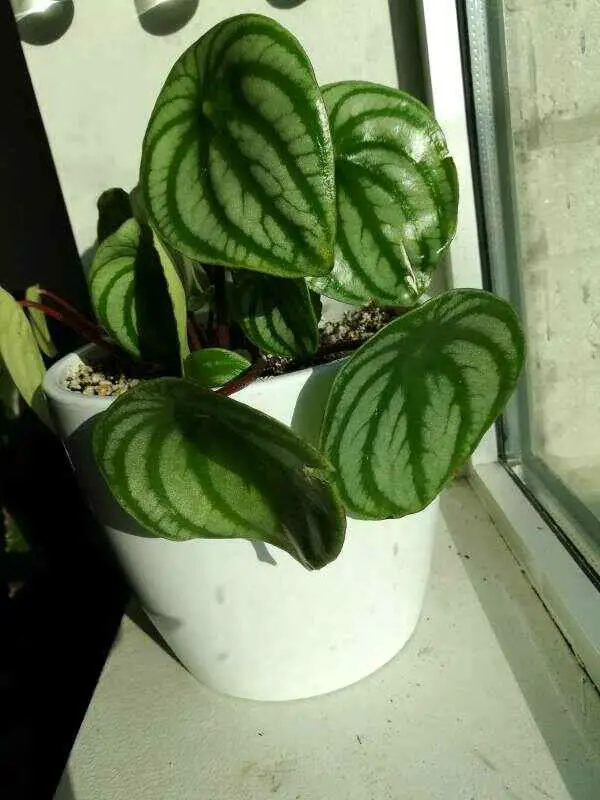
Beautiful Watermelon Peperomia with striking leaves basking in bright light
Watermelon Peperomia Care Requirements and Growing Instructions
Light Requirements
| Minimal amount of light: | 1,000 lux (100 FC) |
| Optimal amount of light: | 2,500+ lux (250+ FC) |
| Direct sun tolerance: | 2-3 hours |
| Category: | Medium light |
Watermelon Peperomia plant has medium light requirements. It needs at least 1,000 lux (100 foot-candles). Your indoor plants will achieve optimal growth if you provide it with light over 2,500 lux (250 foot-candles).
The more indirect light your plant gets the more it will photosynthesize. More photosynthesis means faster growth and a bigger, healthier plant that is more resistant to pests and diseases. Peperomia can handle 2-3 hours of weak direct sunlight, in the early morning or late afternoon. For more information on what bright indirect light means for plants, check out the linked blog post.
Watermelon Peperomia Water Needs
You should water your Watermelon Peperomias when the soil dries fully, all the way to the bottom of the pot. The easiest way to know if the soil is dry enough is to use a chopstick. Take a chopstick and stick it to the bottom of the pot. If the chopstick comes out completely dry, without any soil attached to it, this is a sign that you should water your plant.
Peperomias tolerate better staying dry than staying wet.
How often you should water your Watermelon Peperomia houseplant depends on your environment (amount of light, type of pot, type of soil, humidity…) That’s why it’s best to always check the soil before watering with a chopstick, to avoid underwatering or overwatering.
Ideal Soil For Growing Peperomia Argyreia Plants
The ideal soil for growing Watermelon Peperomia (Peperomia Argyreia) plants will include the following:
- 2 parts of any commercial potting mix
- 1 part of perlite or another inorganic amendment (pumice, coarse sand…)
Watermelon Peperomia prefers well-draining potting soil. Pot it in a pot with drainage holes. Otherwise, you risk the water pooling up at the bottom of the pot, which can cause root rot.
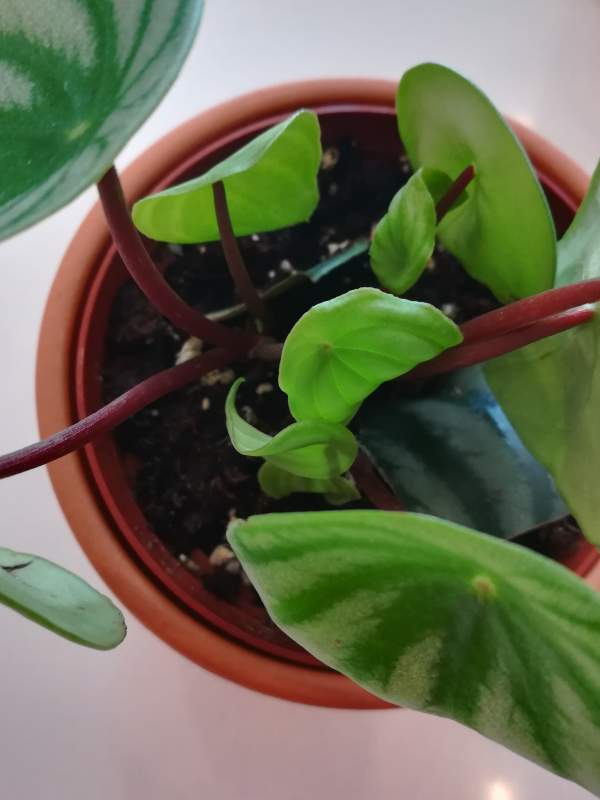
Healthy Peperomia in high-quality soil growing new leaves
Adding amendments to a store-bought potting mix is a great way to improve drainage and add oxygen to your indoor plants. Amendments like perlite, pumice, bark, and similar help create macro pores in the soil. Macro pores contain oxygen. Roots need oxygen. More oxygen for roots equals a sturdier, happier plant with more resilience to pests and diseases.
Humidity Needs
Watermelon Peperomia is a tropical plant originating from South America, and according to the University of Georgia Extension, it is used to 25% to 50% humidity in its natural habitat. However, it tolerates lower humidity levels, like most tropical houseplants. Since the plant grows inside the room of your home or office, humidity won’t be a problem.
Temperature Requirements
Watermelon Peperomia prefers temperatures between 65°F (18°C) and 75F (24°C), according to the University of Georgia Extension, but it will tolerate temperatures down to 55°F (13°C). Make sure to protect your houseplant from cold drafts during winter.
Fertilizing
To fertilize Watermelon Peperomia, use a high-quality liquid fertilizer like the Sill fertilizer. Mix 1 teaspoon of the fertilizer with a gallon of water and use once a month. You don’t have to wait for the growing season in the spring and summer months to fertilize it. As long as your plant is actively growing, you can fertilize it.
The Sill fertilizer has an excellent N-P-K ratio (Nitrogen-Phosphorus-Pottasium) of 9:3:6.
If your Watermelon Peperomia plant is healthy and thriving, and you repot it once a year, it is not necessary to fertilize it. Annual repotting will provide a sufficient amount of nutrients. You can give it a boost if you want to.
Whichever plant fertilizer you decide to use, carefully follow the manufacturer’s instructions. Different fertilizers will have different usage instructions and application frequencies.
Repotting Your Watermelon Peperomia:
These are the steps for repotting your Watermelon Peperomia:
- Choose a pot that’s one size bigger than the one you’ve been using
- Fill the pot ⅓ with a potting mix (2 parts of any commercial potting mix, 1 part of perlite, or another amendment)
- Take your Watermelon Peperomia out of its pot
- Loosen the rootball and inspect it
- Prune rotten, dead or diseased roots, if any
- Put your indoor plant in the new pot
- Fill around the plant with fresh soil
- Press the soil around your Peperomia and water it
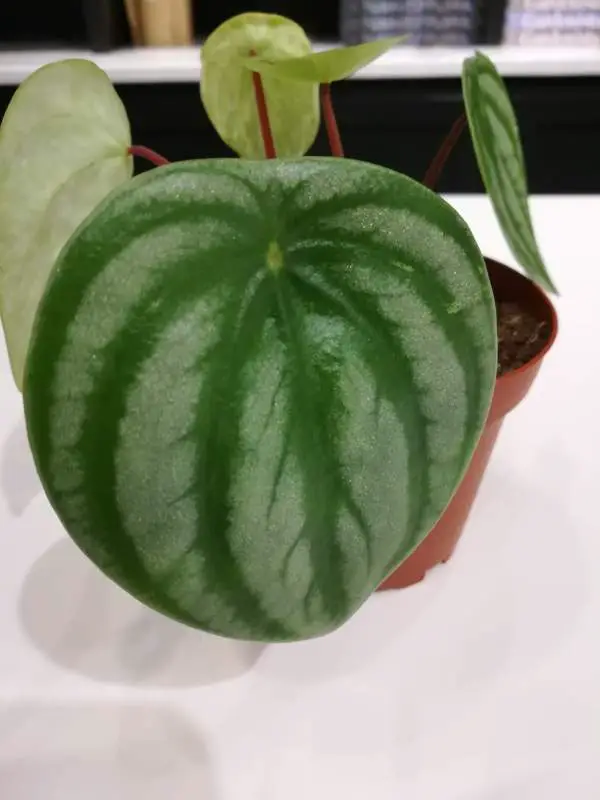
Watermelon Peperomia leaf
Repot your Watermelon Peperomia once a year, or sooner if you notice that it’s outgrowing its pot. Repotting houseplants provides great benefits for your plants because the soil gets compacted over time and loses nutrients as the plants are growing and absorbing them. The roots need oxygen. Oxygen is vital for the proper growth and development of the roots, since they absorb oxygen and release CO2. And oxygen is provided by fresh non-compacted soil.
Toxicity For Humans
Watermelon Peperomia, like its other cousins from the Peperomia genus, is not toxic for humans, according to the University of California Department.
Toxicity For Pets
According to ASPCA, the Watermelon Peperomia plant is not toxic to cats and dogs. However, if you want your plant to keep beautiful foliage, it’s best to keep it out of the reach of your pet so it won’t nibble on it.
Pruning
You can prune your Watermelon Peperomia in the below-listed cases:
- if it has diseases or pests
- if the leaves are dead (dry and brown)
- or if you want your plant to be bushier
If your indoor plant has diseases or pests, or if the leaves are turning brown or dying, you should remove the parts that are diseased, pest infested or dead. Prune the affected leaves and stems with a pair of pruning shears that you have previously sterilized with rubbing alcohol.
You can prune your Watermelon Peperomia if you want it to be bushier. Select where you want the plant to branch out and prune it above the closest node with a pair of sterilized pruning shears. Your plant should branch out from the node below the cut.
If your Peperomia is healthy, you don’t have to prune it.
Watermelon Peperomia Propagation
You can propagate the Watermelon Peperomia plant using the following methods:
- stem cutting in water or soil
- leaf cutting in water or soil
- division
To propagate Watermelon Peperomia using leaf cuttings in water, follow the steps listed below:
- Pick a larger, healthy leaf
- Pull the leaf off the stem with your fingers (try to pull off the whole petiole)
- Put the leaf in a propagation vessel with water
- Place the propagation vessel in bright indirect light
- Replace water weekly
- In a couple of weeks, the cutting will develop roots
- When there is two to three inches of roots, plant the leaf cutting in soil
- Water the soil
- In a few weeks, you will see a new shoot growing out of it
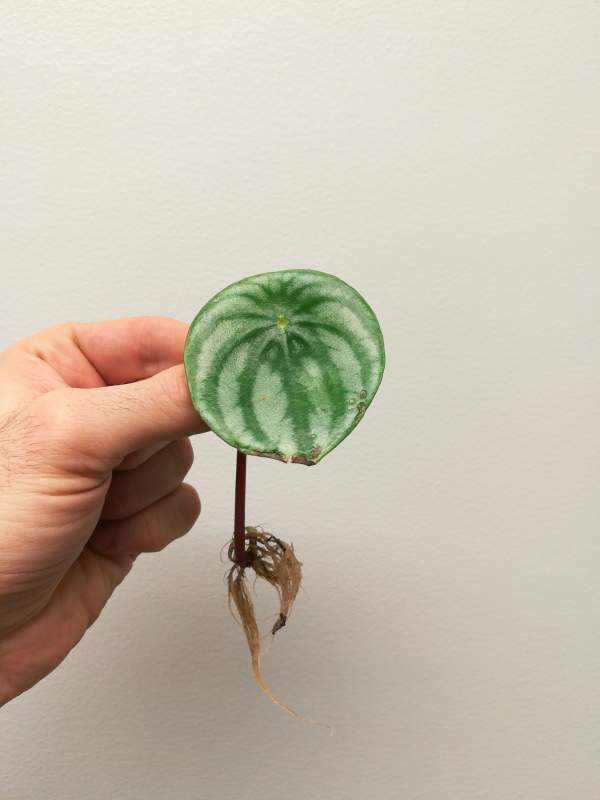
Rooted leaf cutting of Watermelon Peperomia
Unlike some plants that will only grow roots from a leaf, Watermelon Peperomia will actually grow new shoots.
Check out my post about leaf propagation:
How Long Does It Take to Propagate Watermelon Peperomia?
It takes on average about 3-5 weeks to propagate your Watermelon Peperomia plant. If you’re choosing the water method, it will take about a month for the leaf with the petiole to grow two to three inches of roots, after which you can plant it in soil.
The Most Common Watermelon Peperomia Pests And Diseases
The Watermelon Peperomia plant can be afflicted by several fungal and viral diseases, as well as pests. The good news is that you can prevent these issues by providing your plant with just the right amount of light and water, as well as by using fresh, pathogen-free potting mix when you repot your Peperomia.
Common Pests Affecting Growth
Common pests affecting the growth of Watermelon Peperomia are listed below:
- Fungus gnats
- Root mealybugs
- Spider mites
- Scales
- Thrips
- Caterpillars
Common Fungal Diseases Affecting Growth
Common Fungal Diseases affecting growth of Watermelon Peperomia are listed below:
- Cercospora leaf spot
- Phytophthora and Pythium stem and root rot
- Sclerotium stem rot
- Phyllosticta leaf spot
- Rhizoctonia leaf spot
Common Viral Diseases Affecting Growth
A common viral disease on Watermelon Peperomias caused by viruses is ring spot (Peperomia ring spot virus). Symptoms include distorted leaf shape, or rings of light or dark pigmentation, or necrotic lesions (brown sections) on the variegated cultivars. Plants affected by the ring spot virus should be discarded as it’s not possible to cure them.
Common Growing Issues With Peperomia Argyreia
Leaves Turning Yellow
The leaves of your indoor plants can turn yellow due to multiple reasons which include underwatering, overwatering, lack of light, or too much sun. Not providing sufficient water (underwatering), can cause older leaves to turn yellow and die. Providing too much water or watering too frequently will do the same. If your plant isn’t getting sufficient light, it won’t have the energy to support all leaves, so older leaves will turn yellow and die. When your plant is exposed to too much sun, the leaves get bleached, and yellowish, especially during longer exposure to direct sunlight.
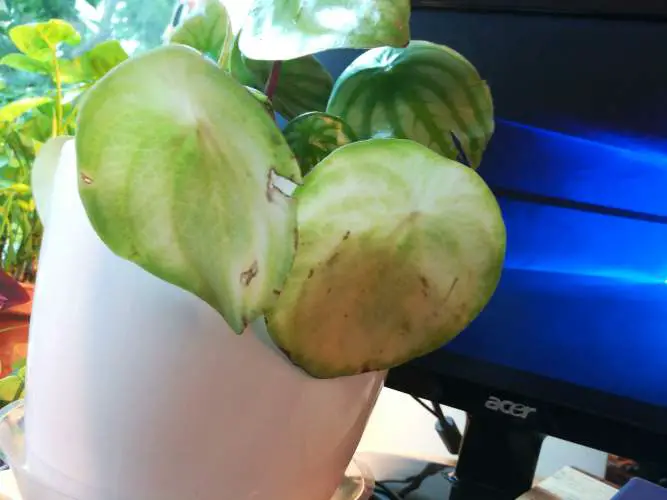
Peperomia bleached leaves due to too much direct sun
Leaves Turning Brown
If you notice that your plant’s leaves are turning brown, it could be just normal leaf senescence (leaf loss), which means that the older leaves are dying as the new leaves grow. It could also be caused by a sunburn. If the plant is exposed to very intense sun, the leaves will burn and appear brown, burnt, and crispy.
Another possible culprit is a viral disease caused by the Ring spot virus, which causes necrotic lesions (brown areas) on plants with variegated leaves, and those leaves that are infected usually fall off.
Curling Leaves
The leaves of your plant will start to curl if the plant is infested with thrips. Thrips are small, thin insects that feed on leaves, by sucking out the sap from the plant. Infested leaves start to curl or change shape, and silver-gray scars show up on the areas infected with thrips.
Drooping Leaves
Drooping leaves can be caused by underwatering, overwatering, pests, diseases and normal leaf senescence. That can happen either because the plants are underwatered, so they needs more water, or because they have been overwatered, the roots have rotted and now they can’t absorb moisture from the soil. The symptoms of overwatering and underwatering are similar. That’s why it’s important to have proper watering practices and not water until the soil has fully dried out.
Watermelon Peperomia FAQs
How Long Does Watermelon Peperomia Live?
Watermelon Peperomia is a perennial, and according to The Royal Horticultural Society, with proper care it can live for more than 5 years.
Does My Watermelon Peperomia Need to be Misted?
No, your Watermelon Peperomia doesn’t need to be misted because it doesn’t require high humidity. Misting also doesn’t increase humidity for more than a few minutes. As soon as the water evaporates, which takes a few minutes, the humidity returns to normal. Misting also increases the chances of fungal and bacterial infections, so it’s not recommended.
Yours Truly,



Related Posts
Sansevieria Black Gold (Snake Plant Care GUIDE!)
Spathiphyllum Sensation (FULLY Explained!)
Alocasia Stingray Care